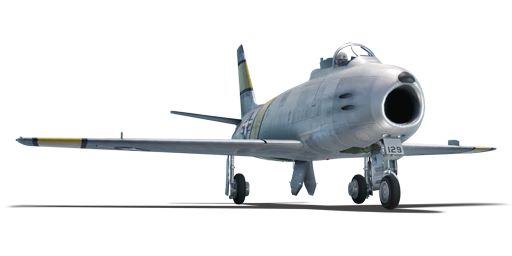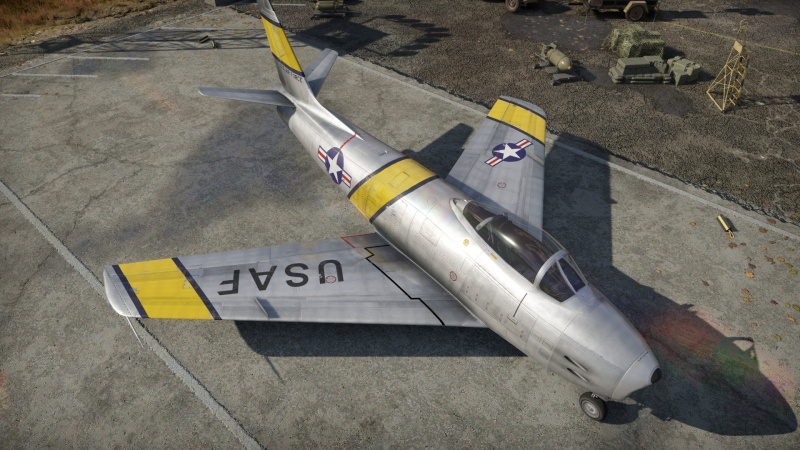F-86F-2
| This page is about the American jet fighter F-86F-2. For other variants, see F-86 (Family). |
Contents
Description
The F-86F-2 Sabre is a rank American jet fighter with a battle rating of (AB), (RB), and (SB). It was introduced in Update 1.35.
General info
Flight performance
| Characteristics | Max Speed (km/h at 0 m - sea level) |
Max altitude (metres) |
Turn time (seconds) |
Rate of climb (metres/second) |
Take-off run (metres) | |||
|---|---|---|---|---|---|---|---|---|
| AB | RB | AB | RB | AB | RB | |||
| Stock | 1,095 | 1,089 | 24.7 | 25.9 | 38.8 | 35.9 | 750 | |
| Upgraded | 1,115 | 1,106 | 23.6 | 24.0 | 56.5 | 46.7 | ||
Details
| Features | |||||
|---|---|---|---|---|---|
| Combat flaps | Take-off flaps | Landing flaps | Air brakes | Arrestor gear | Drogue chute |
| ✓ | ✓ | ✓ | ✓ | X | X |
| Limits | ||||||
|---|---|---|---|---|---|---|
| Wings (km/h) | Gear (km/h) | Flaps (km/h) | Max Static G | |||
| Combat | Take-off | Landing | + | - | ||
| 590 | 550 | 350 | ~11 | ~6 | ||
| Optimal velocities (km/h) | |||
|---|---|---|---|
| Ailerons | Rudder | Elevators | Radiator |
| < 850 | < 600 | < 650 | N/A |
Engine performance
| Engine | Aircraft mass | |||||
|---|---|---|---|---|---|---|
| Engine name | Number | Empty mass | Wing loading (full fuel) | |||
| General Electric J47-GE-27 | 1 | 5,570 kg | 243 kg/m2 | |||
| Engine characteristics | Mass with fuel (no weapons load) | Max Takeoff Weight | ||||
| Weight (each) | Type | 7m fuel | 20m fuel | 26m fuel | ||
| 1,150 kg | Axial-flow turbojet | 5,927 kg | 6,569 kg | 6,866 kg | 9,530 kg | |
| Maximum engine thrust @ 0 m (RB / SB) | Thrust to weight ratio @ 0 m (100%) | |||||
| Condition | 100% | WEP | 7m fuel | 20m fuel | 26m fuel | MTOW |
| Stationary | 2,626 kgf | N/A | 0.44 | 0.40 | 0.38 | 0.28 |
| Optimal | 2,626 kgf (0 km/h) |
N/A | 0.44 | 0.40 | 0.38 | 0.28 |
Survivability and armour
- 6.35 mm steel - in front of cockpit
- 12.7 mm steel - behind pilot
- 38 mm steel - armoured windscreen
- 20 mm steel pilot's headrest
Modifications and economy
Armaments
Offensive armament
The F-86F-2 is armed with:
- 4 x 20 mm FMC T-160 cannons, nose-mounted (115 rpg = 460 total)
Suspended armament
The F-86F-2 can be outfitted with the following ordnance:
- Without load
- 16 x HVAR rockets
- 2 x 1,000 lb AN-M65A1 Fin M129 bombs (2,000 lb total)
Usage in battles
In RB, speed is life on this plane. First thing that should be done after takeoff is gaining at least 800-900 kph IAS in level flight and zoom climbing to around 2 km(or we can fight even at the deck, all depends on situation). Maintaining speed at 800 kph is very important. BnZ is main tactic, don't engage in vertical with MiG-15bis. Sabre easily outdive MiG-15bis(Sabre have higher top speed, which means MiG-15bis won't be able to catch Sabre in level flight/dive). Avoid flying slow and turnfighting.
Radars
The F-86F-2 is equipped with an AN/APG-30 rangefinding radar, located in the nose of the aircraft. It will automatically detect other planes within the scanning area and display the range to the closest target. It is linked with a gyro gunsight and can help with aiming at close range.
| AN/APG-30 - Rangefinding radar | |||
|---|---|---|---|
| Maximum Detection Range |
Guaranteed Detection Range |
Max Azimuth Scan Angle |
Max Elevation Scan Angle |
| 2,750 m | 300 m | ±9° | ±9° |
Pros and cons
Pros:
- Very fast roll rate
- Very accurate high-velocity cannons with little recoil
- Excels overall at high-speed manoeuvres, good for snapshots
- Good rate of turn in the horizontal
- Good zooming ability
- Energy retention superior to MiG-15
- Superior acceleration from high speeds to top speed than MiG-15
- Heavy bombs available if desired
Cons:
- Extremely high rate of fire demand strict trigger discipline
- Stock guns quickly jam when the trigger is held down
- Poor acceleration from low speeds compared to MiG-15
- Poor rate of climb
- Wings easier to rip when boosters equipped
- Air-brake is less effective than some opponents'
History
The F-86F-2 was the designation given to 10 aircraft (4 F-86E and 6 F-86F) modified to carry the M39 Revolver cannon in October 1952. They were fitted with larger and strengthened gun bays to make them able to receive the new cannons. They were tested at Edwards AFB and the Air Proving Ground at Eglin AFB. Eight of these aircraft were then shipped to Japan (two were lost during testing due to the compressors ingesting excessive propellant gases from the cannons). Seven of these aircraft were then deployed to Kimpo Airfield as "Project GunVal" for a 16-week combat field trial in early 1953.
The F-86F-2 is the official designation for F-86E and F aircraft that were retrofitted with strengthened and enlarged gun bays to carry the new T-160 cannon developed from the captured Mauser MG 213, a German autocannon which never saw service. The aircraft were flight tested at Edwards and Eglin Air Force Bases. The aircraft were then relocated to Kimpo Airfield for tests in actual combat. Two aircraft were lost after the engine ingested excessive amounts of exhaust gases from the cannons.
The F-86 is considered one of the best fighter jets of the Korean War. It is the most-produced Western fighter, with almost 10,000 aircraft produced by the US, Australia, Canada (as the re-engined CL-13), Italy, and Japan.
The F-86 was developed by North American Aviation, the creator of the venerable P-51 Mustang. The XP-86 prototype was created to meet the USAF requirement for a high-altitude escort fighter. It was derived from the Navy's FJ-1 Fury, a transitional fighter jet that borrowed the wings, tail surfaces and canopy from the P-51D. The XP-86 was under threat of cancellation because the XP-80 and XP-84 had similar performance characteristics and were farther ahead in development. However, North American designers made a radical change to the design and replaced the straight wing with a swept wing, which was shown by seized German research to greatly reduce drag and increase performance at high speed. The resulting performance boost was so significant that the swept-wing prototype of the XP-86 was supposedly able break the sound barrier in a dive a few days before Chuck Yeager made his official attempt.
The F-86F-2 is the designation for four F-86E and six F-86F aircraft that were retrofitted to carry four 20mm T-160 (later designated M39) revolver cannons. The cannon was derived from the Mauser MG 213, a prototype aircraft cannon developed by the Germans at the end of World War II, which also served as a basis for the British ADEN and French DEFA cannons. The aircraft were deployed to Kimpo Airfield for trials in combat in 1953. Despite losing two aircraft after compressor stalls from ingesting too many exhaust gases from the new cannons, the M-39 cannon became the standard armament for the F-86H, a fighter-bomber variant with a more powerful engine.
Media
Excellent additions to the article would be video guides, screenshots from the game, and photos.
See also
- Related development
- Canadair Sabre (those Sabres manufactured with the designator "CL")
- North American F-86A/F
- North American F-86D Sabre
- North American F-100 Super Sabre
- North American FJ-4 Fury
- Aircraft of comparable role, configuration and era
- Dassault Super Mystère
- Grumman F-9 Cougar
- Hawker Hunter
- Lavochkin La-15
- Mikoyan-Gurevich MiG-15
- Mikoyan-Gurevich MiG-17
- Saab J29 Tunnan
External links
| North American Aviation | |
|---|---|
| Fighters | |
| P-51A | P-51 · P-51A |
| P-51C | P-51C-10 |
| P-51D | P-51D-5 · P-51D-10 · P-51D-20-NA · P-51D-30 |
| P-51H | P-51H-5-NA |
| Twin-engine fighters | F-82E |
| Jet fighters | F-86A-5 · F-86F-2 · F-86F-25 · F-86F-35 · F-100D |
| Strike aircraft | A-36 · PBJ-1H · PBJ-1J |
| FJ-4B · FJ-4B VMF-232 | |
| Bombers | B-25J-1 · B-25J-20 |
| Export/Licence | ▂B-25J-30 · ␗B-25J-30 |
| ▄Mustang Mk IA · F-6C-10-NA · ␗P-51C-11-NT · ␗P-51D-20 · J26 David · J26 · P-51D-20-NA · ␗P-51K | |
| F-86F-30 ▅ · ␗F-86F-30 · F-86F-40 ▅ · F-86F-40 JASDF▅ · ␗F-86F-40 | |
| ◄F-86K · ▄F-86K (Italy) · ▄F-86K (France) | |
| ␗F-100A · ▄F-100D · ␗F-100F | |
| Captured | ▅P-51C-11-NT |
| Canadair Limited license-built the F-86 as the CL-13 for use in Canada and export to Europe. | |
| Fiat license-built the F-86K for the Italian Air Force though another 120 NAA built F-86Ks were also sold to the Italians. | |
| See Also | Mitsubishi Heavy Industries · Canadair Limited · Fiat Aviation |
| USA jet aircraft | |
|---|---|
| Fighters | |
| F9F | F9F-2 · F9F-5 · F9F-8 |
| F-80 | F-80A-5 · F-80C-10 |
| F-84 | F-84B-26 · F-84F · F-84G-21-RE |
| F-86 | F-86A-5 · F-86F-25 · F-86F-2 · F-86F-35 |
| F-89 | F-89B · F-89D |
| F-100 | F-100D |
| F-104 | F-104A · F-104C |
| F-4 | F-4C Phantom II · F-4E Phantom II · F-4J Phantom II · F-4S Phantom II |
| F-5 | F-5A · F-5C · F-5E · F-20A |
| F-8 | F8U-2 · F-8E |
| F-14 | F-14A Early · ▄F-14A IRIAF · F-14B |
| F-15 | F-15A · F-15C MSIP II · F-15E |
| F-16 | F-16A · F-16A ADF · F-16C |
| Other | P-59A · F2H-2 · F3D-1 · F3H-2 · F4D-1 · F11F-1 |
| Strike Aircraft | |
| FJ-4 | FJ-4B · FJ-4B VMF-232 |
| A-4 | A-4B · A-4E Early |
| A-7 | A-7D · A-7E · A-7K |
| AV-8 | AV-8A · AV-8C · AV-8B Plus · AV-8B (NA) |
| A-10 | A-10A · A-10A Late · A-10C |
| F-111 | F-111A · F-111F |
| Other | A-6E TRAM · F-105D · F-117 |
| Bombers | |
| B-57 | B-57A · B-57B |





